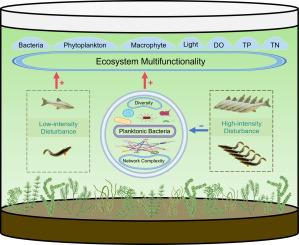High-intensity fish disturbance reduces ecosystem multifunctionality by diminishing planktonic bacterial diversity and network complexity
IF 4.4
1区 环境科学与生态学
Q1 BIODIVERSITY CONSERVATION
引用次数: 0
Abstract
Global environmental change threatens biodiversity and ecosystem functioning, yet the role of species interactions in buffering these impacts remains understudied. In freshwater ecosystems, small omnivorous fish can disrupt ecosystems through predation and nutrient excretion, which could provide models for human pressures on ecosystem structure and functioning. However, the effects of disturbance intensity, as represented by fish densities, on microbial community structure and ecosystem multifunctionality (EMF) are not well understood. Here, we experimentally explored the impact of disturbance intensity using two small omnivorous fish species (Misgurnus anguillicaudatus and Pseudorasbora parva) on the species diversity, co-occurrence network complexity of planktonic bacteria, and multifunctionality of freshwater ecosystems. We found that high-intensity disturbances by the two fish species significantly reduced species diversity, network complexity and EMF, especially for the treatments involving P. parva. However, low-intensity disturbances led to a significant increase in EMF, supporting the intermediate disturbance hypothesis. In addition, the results of linear regression analysis showed that species diversity and network complexity of planktonic bacteria had significantly positive correlations with the EMF. Structural equation modeling (SEM) further confirmed that high-intensity fish disturbances indirectly reduced EMF by decreasing the diversity and network complexity of planktonic bacteria, whereas low-intensity disturbances primarily had direct positive effects on EMF. These findings underscore that protecting planktonic bacteria community structure is critical for sustaining freshwater ecosystems under anthropogenic pressures. We propose managing small omnivorous fish disturbance regimes to preserve microbial diversity and network complexity, offering a novel framework for interaction-oriented conservation in a rapidly changing world.

高强度的鱼类干扰通过减少浮游细菌多样性和网络复杂性来降低生态系统的多功能性
全球环境变化威胁着生物多样性和生态系统功能,但物种相互作用在缓冲这些影响中的作用仍未得到充分研究。在淡水生态系统中,小型杂食性鱼类可以通过捕食和营养排泄破坏生态系统,这可以为人类对生态系统结构和功能的压力提供模型。然而,以鱼类密度为代表的干扰强度对微生物群落结构和生态系统多功能性(EMF)的影响尚不清楚。本文以两种小型杂食性鱼类(Misgurnus anguillicaudatus和Pseudorasbora parva)为研究对象,探讨了干扰强度对淡水生态系统物种多样性、共生细菌网络复杂性和多功能性的影响。我们发现,两种鱼类的高强度干扰显著降低了物种多样性、网络复杂性和EMF,特别是涉及parva的处理。然而,低强度干扰导致EMF显著增加,支持中间干扰假说。此外,线性回归分析结果表明,浮游细菌的物种多样性和网络复杂性与EMF呈显著正相关。结构方程模型(SEM)进一步证实,高强度鱼类干扰通过降低浮游细菌的多样性和网络复杂性间接降低了EMF,而低强度干扰主要对EMF有直接的积极影响。这些发现强调了保护浮游细菌群落结构对于维持淡水生态系统在人为压力下的生存至关重要。我们建议管理小型杂食性鱼类干扰机制,以保护微生物多样性和网络复杂性,为快速变化的世界中以相互作用为导向的保护提供一个新的框架。
本文章由计算机程序翻译,如有差异,请以英文原文为准。
求助全文
约1分钟内获得全文
求助全文
来源期刊

Biological Conservation
环境科学-环境科学
CiteScore
10.20
自引率
3.40%
发文量
295
审稿时长
61 days
期刊介绍:
Biological Conservation is an international leading journal in the discipline of conservation biology. The journal publishes articles spanning a diverse range of fields that contribute to the biological, sociological, and economic dimensions of conservation and natural resource management. The primary aim of Biological Conservation is the publication of high-quality papers that advance the science and practice of conservation, or which demonstrate the application of conservation principles for natural resource management and policy. Therefore it will be of interest to a broad international readership.
 求助内容:
求助内容: 应助结果提醒方式:
应助结果提醒方式:


